2015 NISSAN MICRA ad blue
[x] Cancel search: ad bluePage 4 of 293
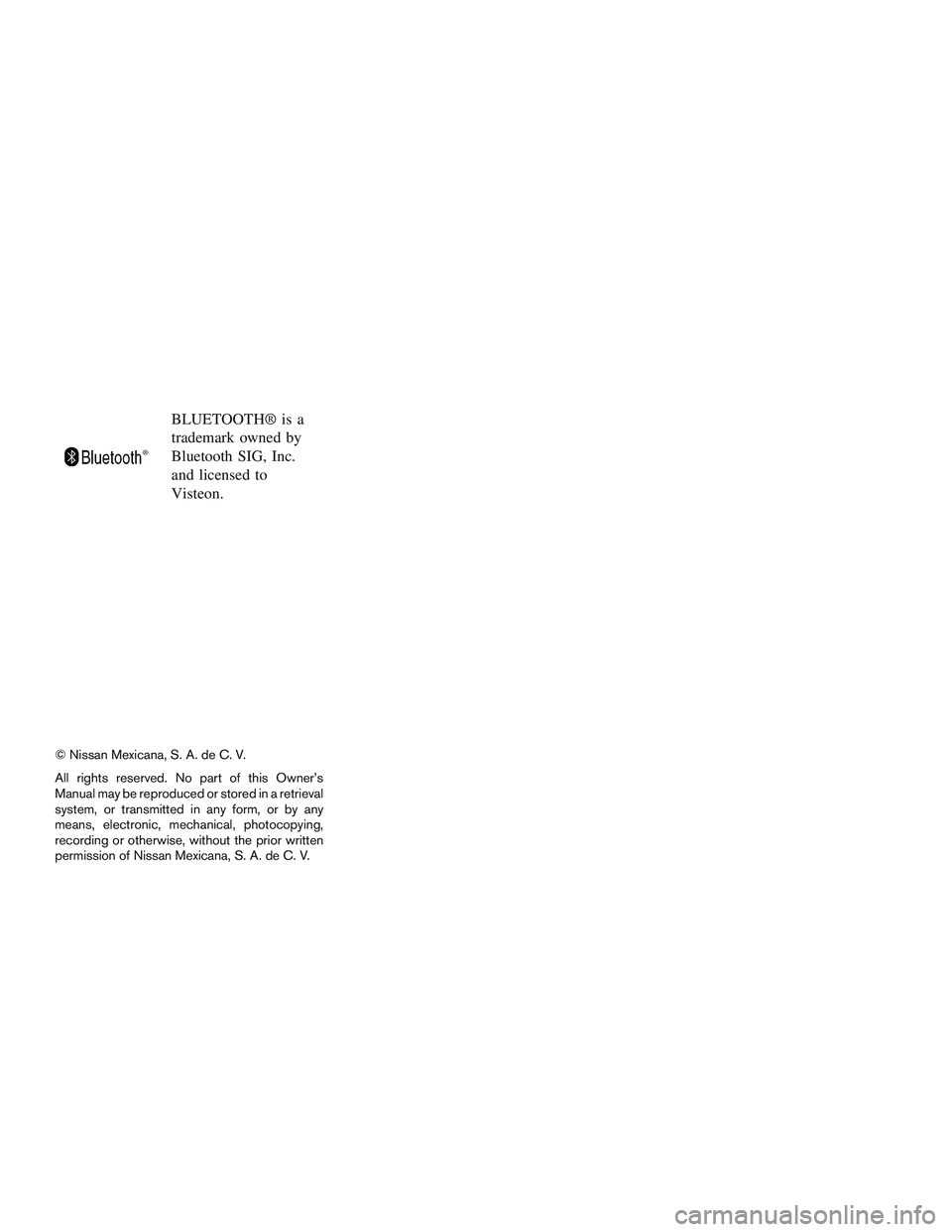
BLUETOOTH® is a
trademark owned by
Bluetooth SIG, Inc.
and licensed to
Visteon.
© Nissan Mexicana, S. A. de C. V.
All rights reserved. No part of this Owner’s
Manual may be reproduced or stored in a retrieval
system, or transmitted in any form, or by any
means, electronic, mechanical, photocopying,
recording or otherwise, without the prior written
permission of Nissan Mexicana, S. A. de C. V.
Page 15 of 293
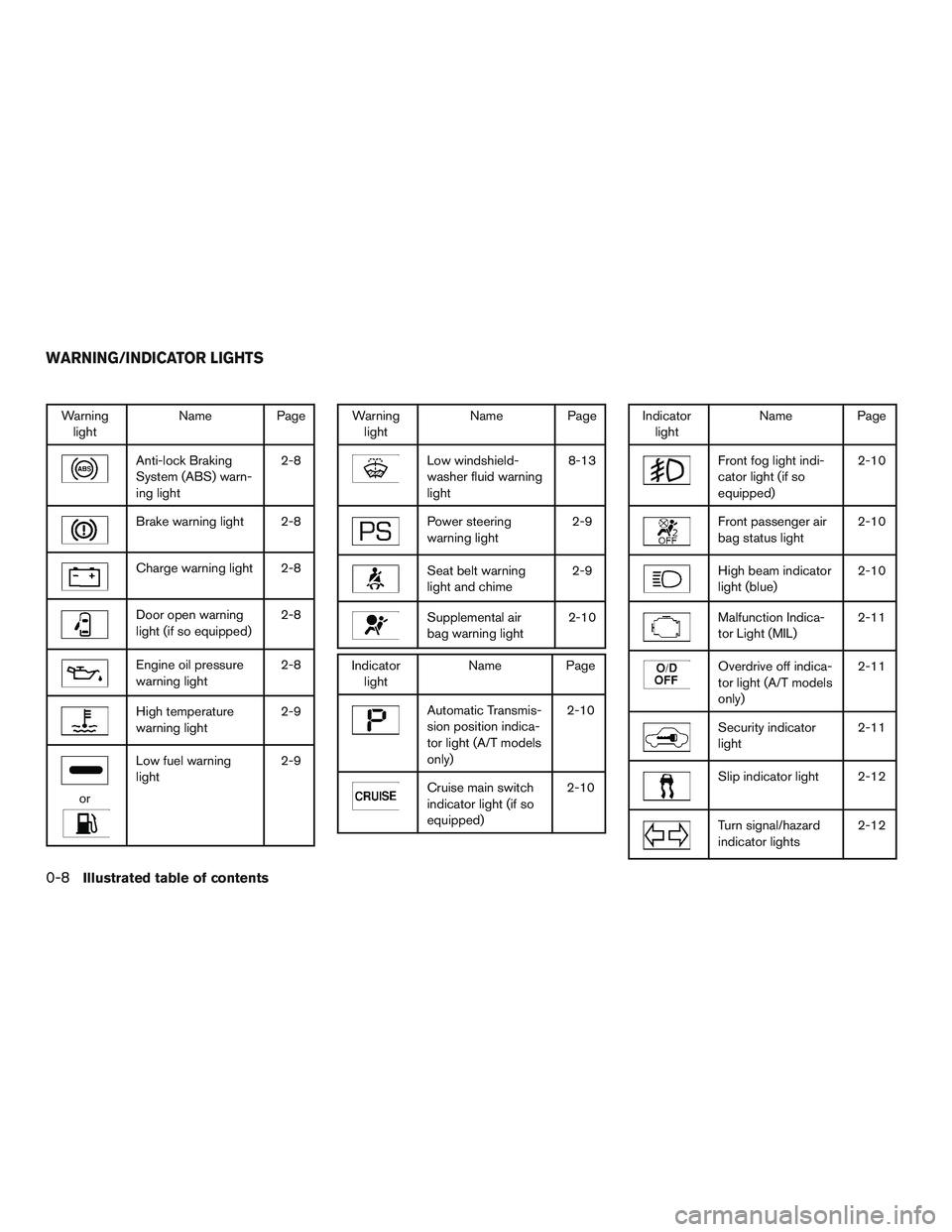
Warninglight Name Page
Anti-lock Braking
System (ABS) warn-
ing light 2-8
Brake warning light 2-8
Charge warning light 2-8
Door open warning
light (if so equipped)
2-8
Engine oil pressure
warning light2-8
High temperature
warning light2-9
or
Low fuel warning
light2-9
Warning
light Name Page
Low windshield-
washer fluid warning
light 8-13
Power steering
warning light
2-9
Seat belt warning
light and chime2-9
Supplemental air
bag warning light2-10
Indicator
light Name Page
Automatic Transmis-
sion position indica-
tor light (A/T models
only) 2-10
Cruise main switch
indicator light (if so
equipped)
2-10
Indicator
light Name Page
Front fog light indi-
cator light (if so
equipped) 2-10
Front passenger air
bag status light
2-10
High beam indicator
light (blue)2-10
Malfunction Indica-
tor Light (MIL)2-11
Overdrive off indica-
tor light (A/T models
only)2-11
Security indicator
light
2-11
Slip indicator light 2-12
Turn signal/hazard
indicator lights2-12
WARNING/INDICATOR LIGHTS
0-8Illustrated table of contents
Page 80 of 293

Anti-lock Braking System (ABS)
warning lightLow windshield-washer fluid
warning lightFront passenger air bag status
lightVehicle Dynamic Control (VDC)
OFF indicator light
Brake warning lightPower steering warning lightHigh beam indicator light (blue)
Charge warning lightSeat belt warning light and
chimeMalfunction Indicator Light
(MIL)
Door open warning light
(if so equipped)Supplemental air bag warning
lightOverdrive OFF indicator light
(A/T models only)
Engine oil pressure warning
lightAutomatic Transmission posi-
tion indicator light (A/T models
only)Security indicator light
High temperature warning lightCruise main switch indicator
light (if so equipped)Slip indicator light
orLow fuel warning
lightFront fog light indicator light
(if so equipped)Turn signal/hazard indicator
lights
CHECKING BULBS
With all doors closed, apply the parking brake
and place the ignition switch the in the ON posi-
tion without starting the engine. The following
lights will come on:,,,,
If equipped, the following lights come on briefly
and then go off:
(red) ,
If any light fails to come on, it may indicate
a burned-out bulb or an open circuit in the
electrical system. Have the system repaired
promptly.
WARNING/INDICATOR LIGHTS AND
AUDIBLE REMINDERS
Instruments and controls2-7
Page 83 of 293

the ON position, the system does not activate the
warning light for the front passenger.
For additional information, refer to “Seat belts” in
the “Safety—Seats, seat belts and supplemental
restraint system” section of this manual for pre-
cautions on seat belt usage.
Supplemental air bag warninglight
When the ignition switch is placed in the ON or
START position, the supplemental air bag warn-
ing light illuminates for about 7 seconds and then
turns off if the SRS air bag systems are opera-
tional. This means the system is operational.
If any of the following conditions occur, the
supplemental front air bags and/or pretensioner
systems need servicing and your vehicle must be
taken to a NISSAN dealer:
● The supplemental air bag warning light re-
mains on after approximately 7 seconds.
● The supplemental air bag warning light
flashes intermittently.
● The supplemental air bag warning light does
not come on at all.
Unless checked and repaired, the supplemental
restraint systems (air bag systems) may not func-
tion properly. For additional information, refer to “Supplemental restraint system” in the “Safety—
Seats, seat belts and supplemental restraint sys-
tem” section of this manual.
WARNING
If the supplemental air bag warning light
is on, it could mean that the supplemental
front air bag and/or pretensioner systems
will not operate in an accident. To help
avoid injury to yourself or others, have
your vehicle checked by a NISSAN dealer
as soon as possible.
INDICATOR LIGHTS
Automatic transmission
position indicator light (A/T
models only)
When the ignition switch is in the ON position,
this indicator light shows the shift lever position.
For additional information, refer to “Driving the
vehicle” in the “Starting and driving” section of
this manual.
Cruise main switch indicatorlight (if so equipped)
The light comes on when the cruise control main
switch is pushed. The light goes out when the
main switch is pushed again. When the cruise main switch indicator light comes on, the cruise
control system is operational.
For additional information, refer to “Cruise con-
trol” in the “Starting and driving” section of this
manual.
Front fog light indicator light (if
so equipped)
The front fog light indicator light illuminates when
the front fog lights are ON. For additional infor-
mation, refer to “Front fog lights” in this section.
Front passenger air bag statuslight
The front passenger air bag status light will be lit
and the passenger front air bag will be OFF
depending on how the front passenger seat is
being used.
For front passenger air bag status light operation,
refer to “Front passenger air bag and status light”
in the “Safety — Seats, seat belts and supple-
mental restraint system” section of this manual.
High beam indicator light(blue)
This blue light comes on when the headlight high
beams are on and goes out when the low beams
are selected.
2-10Instruments and controls
Page 118 of 293
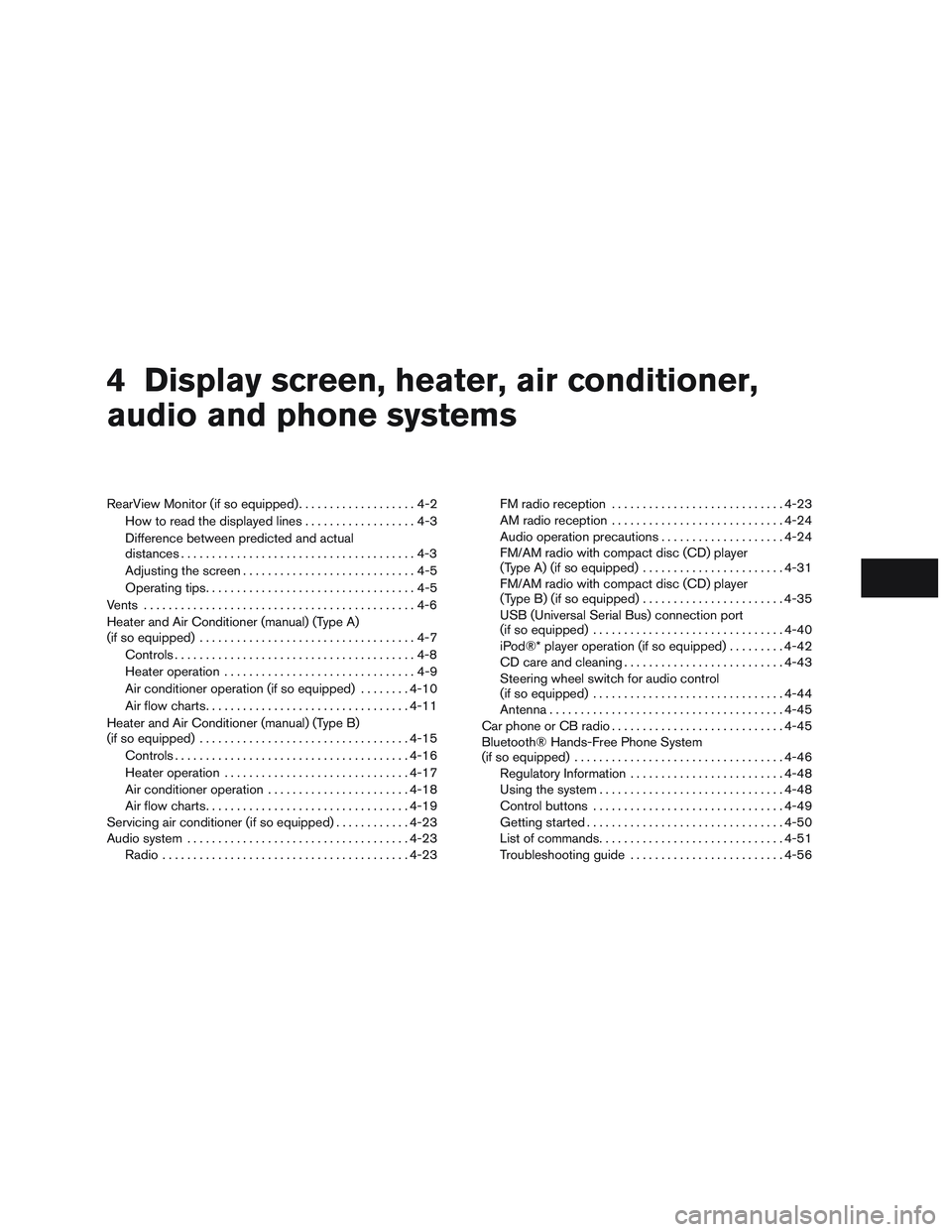
4 Display screen, heater, air conditioner,
audio and phone systems
RearView Monitor (if so equipped)...................4-2
How to read the displayed lines ..................4-3
Difference between predicted and actual
distances ......................................4-3
Adjusting the screen ............................4-5
Operating tips ..................................4-5
Vents ............................................4-6
Heater and Air Conditioner (manual) (Type A)
(if so equipped) ...................................4-7
Controls .......................................4-8
Heater operation ...............................4-9
Air conditioner operation (if so equipped) ........4-10
Air flow charts ................................. 4-11
Heater and Air Conditioner (manual) (Type B)
(if so equipped) .................................. 4-15
Controls ...................................... 4-16
Heater operation .............................. 4-17
Air conditioner operation .......................4-18
Air flow charts ................................. 4-19
Servicing air conditioner (if so equipped) ............4-23
Audio system .................................... 4-23
Radio ........................................ 4-23FM radio reception
............................ 4-23
AM radio reception ............................ 4-24
Audio operation precautions ....................4-24
FM/AM radio with compact disc (CD) player
(Type A) (if so equipped) .......................4-31
FM/AM radio with compact disc (CD) player
(Type B) (if so equipped) .......................4-35
USB (Universal Serial Bus) connection port
(if so equipped) ............................... 4-40
iPod®* player operation (if so equipped) .........4-42
CD care and cleaning .......................... 4-43
Steering wheel switch for audio control
(if so equipped) ............................... 4-44
Antenna ...................................... 4-45
Car phone or CB radio ............................ 4-45
Bluetooth® Hands-Free Phone System
(if so equipped) .................................. 4-46
Regulatory Information ......................... 4-48
Using the system .............................. 4-48
Control buttons ............................... 4-49
Getting started ................................ 4-50
List
of commands .............................. 4-51
Troubleshooting guide ......................... 4-56
Page 163 of 293
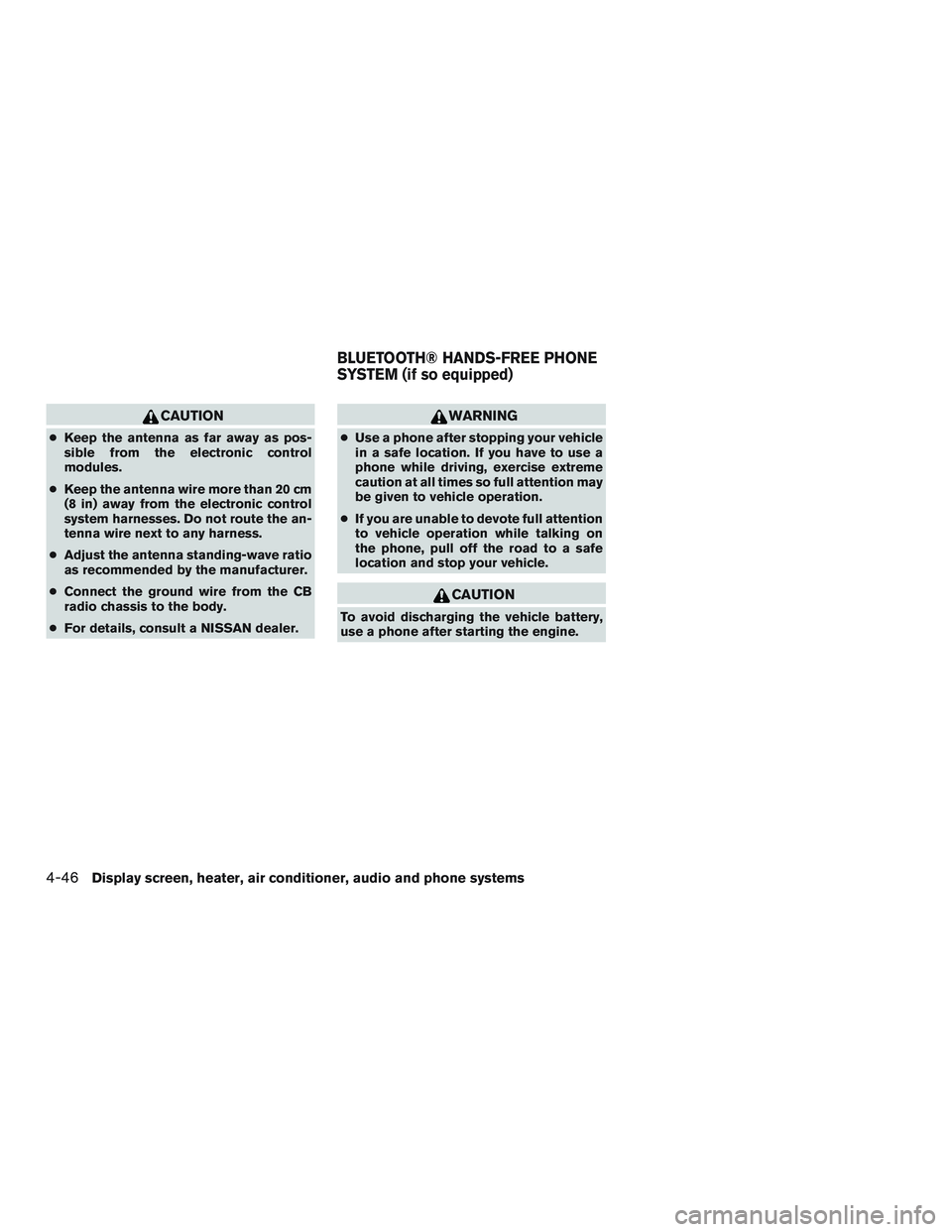
CAUTION
●Keep the antenna as far away as pos-
sible from the electronic control
modules.
● Keep the antenna wire more than 20 cm
(8 in) away from the electronic control
system harnesses. Do not route the an-
tenna wire next to any harness.
● Adjust the antenna standing-wave ratio
as recommended by the manufacturer.
● Connect the ground wire from the CB
radio chassis to the body.
● For details, consult a NISSAN dealer.
WARNING
●Use a phone after stopping your vehicle
in a safe location. If you have to use a
phone while driving, exercise extreme
caution at all times so full attention may
be given to vehicle operation.
● If you are unable to devote full attention
to vehicle operation while talking on
the phone, pull off the road to a safe
location and stop your vehicle.
CAUTION
To avoid discharging the vehicle battery,
use a phone after starting the engine.
BLUETOOTH® HANDS-FREE PHONE
SYSTEM (if so equipped)
4-46Display screen, heater, air conditioner, audio and phone systems
Page 164 of 293
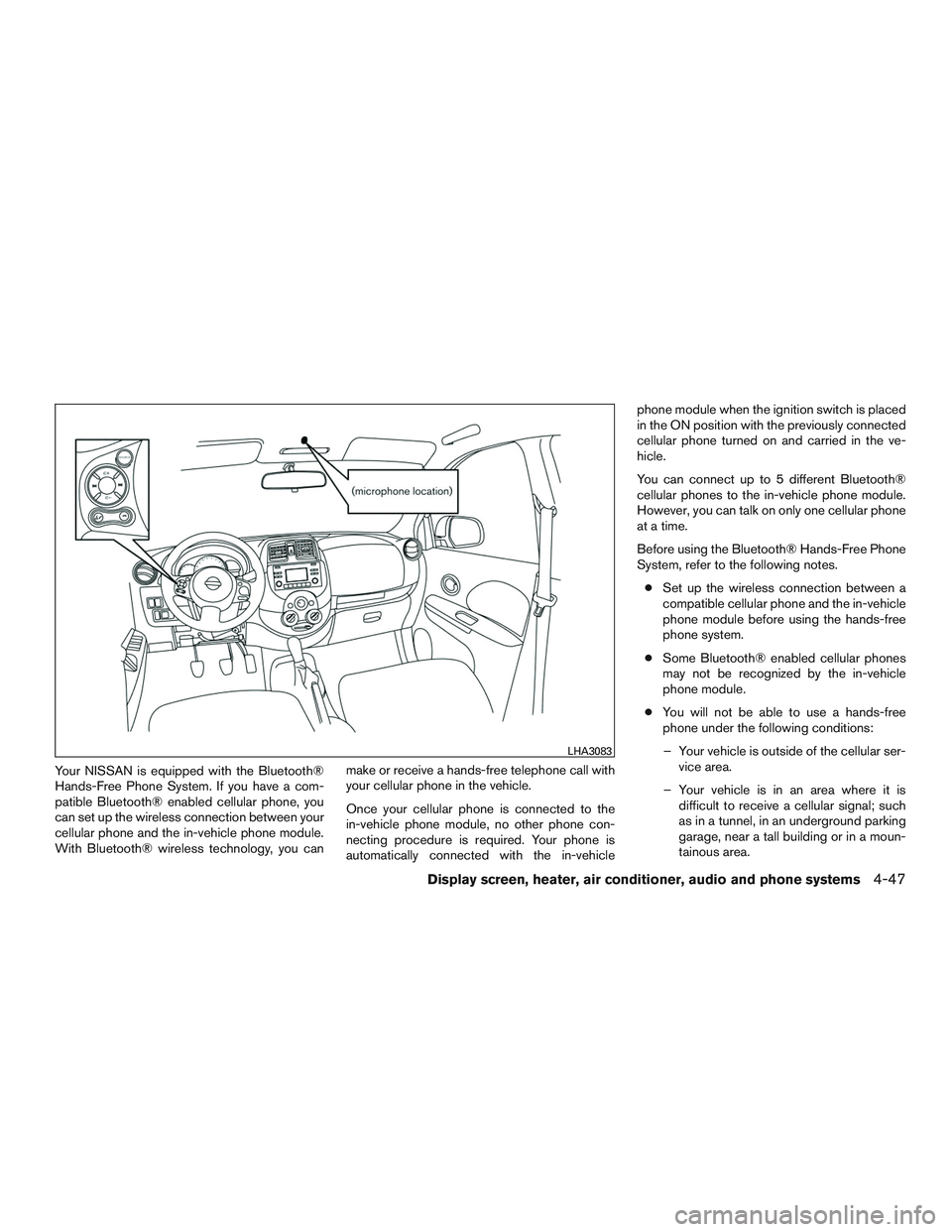
Your NISSAN is equipped with the Bluetooth®
Hands-Free Phone System. If you have a com-
patible Bluetooth® enabled cellular phone, you
can set up the wireless connection between your
cellular phone and the in-vehicle phone module.
With Bluetooth® wireless technology, you canmake or receive a hands-free telephone call with
your cellular phone in the vehicle.
Once your cellular phone is connected to the
in-vehicle phone module, no other phone con-
necting procedure is required. Your phone is
automatically connected with the in-vehiclephone module when the ignition switch is placed
in the ON position with the previously connected
cellular phone turned on and carried in the ve-
hicle.
You can connect up to 5 different Bluetooth®
cellular phones to the in-vehicle phone module.
However, you can talk on only one cellular phone
at a time.
Before using the Bluetooth® Hands-Free Phone
System, refer to the following notes.
● Set up the wireless connection between a
compatible cellular phone and the in-vehicle
phone module before using the hands-free
phone system.
● Some Bluetooth® enabled cellular phones
may not be recognized by the in-vehicle
phone module.
● You will not be able to use a hands-free
phone under the following conditions:
– Your vehicle is outside of the cellular ser- vice area.
– Your vehicle is in an area where it is difficult to receive a cellular signal; such
as in a tunnel, in an underground parking
garage, near a tall building or in a moun-
tainous area.
LHA3083
Display screen, heater, air conditioner, audio and phone systems4-47
Page 165 of 293
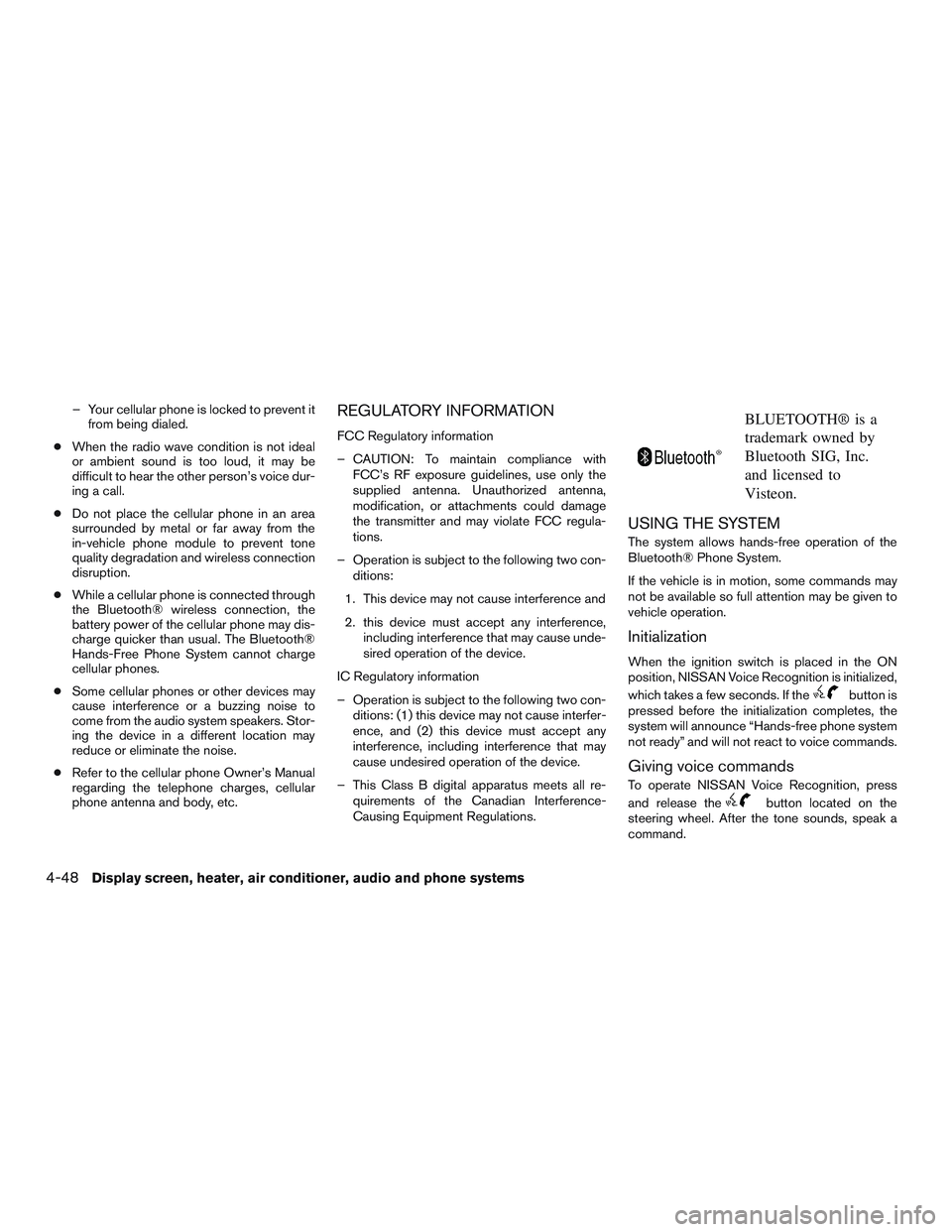
– Your cellular phone is locked to prevent itfrom being dialed.
● When the radio wave condition is not ideal
or ambient sound is too loud, it may be
difficult to hear the other person’s voice dur-
ing a call.
● Do not place the cellular phone in an area
surrounded by metal or far away from the
in-vehicle phone module to prevent tone
quality degradation and wireless connection
disruption.
● While a cellular phone is connected through
the Bluetooth® wireless connection, the
battery power of the cellular phone may dis-
charge quicker than usual. The Bluetooth®
Hands-Free Phone System cannot charge
cellular phones.
● Some cellular phones or other devices may
cause interference or a buzzing noise to
come from the audio system speakers. Stor-
ing the device in a different location may
reduce or eliminate the noise.
● Refer to the cellular phone Owner’s Manual
regarding the telephone charges, cellular
phone antenna and body, etc.REGULATORY INFORMATION
FCC Regulatory information
– CAUTION: To maintain compliance with
FCC’s RF exposure guidelines, use only the
supplied antenna. Unauthorized antenna,
modification, or attachments could damage
the transmitter and may violate FCC regula-
tions.
– Operation is subject to the following two con- ditions:
1. This device may not cause interference and
2. this device must accept any interference, including interference that may cause unde-
sired operation of the device.
IC Regulatory information
– Operation is subject to the following two con- ditions: (1) this device may not cause interfer-
ence, and (2) this device must accept any
interference, including interference that may
cause undesired operation of the device.
– This Class B digital apparatus meets all re- quirements of the Canadian Interference-
Causing Equipment Regulations.
BLUETOOTH® is a
trademark owned by
Bluetooth SIG, Inc.
and licensed to
Visteon.
USING THE SYSTEM
The system allows hands-free operation of the
Bluetooth® Phone System.
If the vehicle is in motion, some commands may
not be available so full attention may be given to
vehicle operation.
Initialization
When the ignition switch is placed in the ON
position, NISSAN Voice Recognition is initialized,
which takes a few seconds. If the
button is
pressed before the initialization completes, the
system will announce “Hands-free phone system
not ready” and will not react to voice commands.
Giving voice commands
To operate NISSAN Voice Recognition, press
and release the
button located on the
steering wheel. After the tone sounds, speak a
command.
4-48Display screen, heater, air conditioner, audio and phone systems